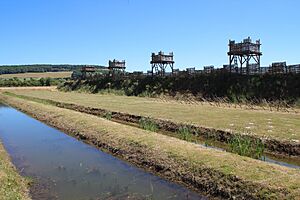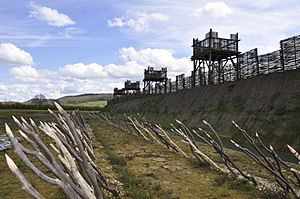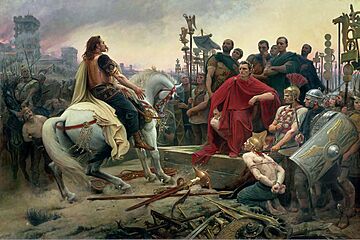Battle of Alesia facts for kids
Quick facts for kids Battle of Alesia |
|||||||||
|---|---|---|---|---|---|---|---|---|---|
| Part of the Gallic Wars | |||||||||
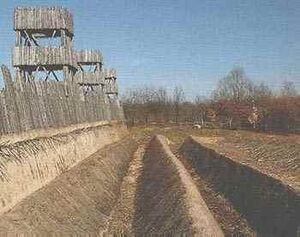 A reconstructed section of the Alesia investment fortifications |
|||||||||
|
|||||||||
| Belligerents | |||||||||
| Roman Republic | Gallic confederation | ||||||||
| Commanders and leaders | |||||||||
| Julius Caesar Mark Antony Titus Labienus Gaius Trebonius |
Vercingetorix Vercassivellaunos Sedullos † Commius Mediomatrici |
||||||||
| Strength | |||||||||
|
10–11 legions (30–50,000 legionaries) 60–75,000 approx. total Romans and allies |
328,000–470,000 total (ancient sources)
<70,000–180,000 total (modern est.)
|
||||||||
| Casualties and losses | |||||||||
| 12,800 killed and wounded | 290,000 (Caesar, exaggerated)
|
||||||||
The Battle of Alesia was a huge fight in September 52 BC. It was the most important battle of the Gallic Wars. This battle happened near a strong Gallic town called Alesia in what is now France.
The Roman army, led by Julius Caesar, fought against many Gallic tribes. These tribes had united under a brave leader named Vercingetorix. This battle was the last big fight between the Gauls and the Romans. It is seen as one of Caesar's greatest military wins. It's also a famous example of a siege, where an army surrounds a town.
The Romans built two lines of strong walls. One wall kept the Gauls inside Alesia. The other wall kept a large Gallic relief army from reaching them. After the Roman victory, the Gauls lost their independence. This meant that modern-day France and Belgium became part of the Roman Republic.
Historians believe the battle site was likely on Mont Auxois. This is above the modern town of Alise-Sainte-Reine in France. However, some people argue this location doesn't quite match Caesar's old descriptions.
Contents
Why did the Battle of Alesia happen?
In 58 BC, Julius Caesar became a powerful Roman governor. He was in charge of three Roman areas, including parts of modern Italy and France. He also commanded four legions, which are large groups of soldiers.
Caesar started the Gallic Wars (58–50 BC) to conquer more land. He wanted to expand the Roman Republic into Gaul. Gaul is roughly where France is today. At first, the Gallic tribes were not united. This made it easier for Caesar to conquer them one by one.
However, things changed in 52 BC. Caesar announced that Gaul would become a Roman province. This meant it would follow Roman laws and religion. The Gauls were very worried about this. They feared the Romans would destroy their sacred lands. These lands were important to their druids, who were like their priests and judges.
This threat finally united the Gallic tribes. A strong leader named Vercingetorix brought many tribes together. They planned a big revolt against the Romans.
How did the battle begin?
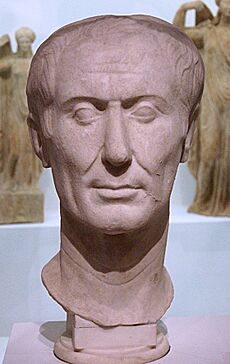
Caesar was in Rome when he heard about the revolt. He quickly went north to stop it from spreading. Vercingetorix decided to try and starve the Romans. He avoided big battles and attacked Roman supply lines instead. He also burned many Gallic towns. This was to stop the Romans from getting food and supplies from them.
Caesar needed supplies, so he attacked the town of Avaricum. Vercingetorix had pulled his army back there. The Romans built strong defenses around Avaricum in just 25 days. They used siege machines to break through the walls. Caesar's army took the town and claimed to have killed 40,000 Gauls. Despite this loss, Vercingetorix kept his Gallic alliance together.
Vercingetorix then went to Gergovia, his own tribe's capital. Caesar followed and tried to capture a nearby hill. However, the Roman attack on Gergovia failed. The Romans were outnumbered and lost many men. This victory for Vercingetorix encouraged more tribes to join him.
Vercingetorix then led his army, mostly cavalry, to stop Caesar. The two armies met in the Battle of the Vingeanne. Caesar won this battle, defeating Vercingetorix's cavalry.
The Siege of Alesia
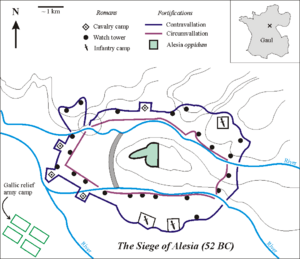
After losing his cavalry, Vercingetorix retreated to Alesia. Alesia was a strong Gallic town on a high hill. Two rivers protected its sides. Caesar decided to surround the town and starve the defenders. Vercingetorix agreed to this, planning to use Alesia as a trap. He sent messages to other Gallic tribes, asking for a large relief army to come help.
Caesar's army built amazing siege works in about a month. They created about 25 miles (40 km) of fortifications. These included trenches for soldiers, moats to stop cavalry, and towers. They also set up hidden traps in front of the trenches.
The Romans built two lines of walls. One wall faced Alesia to keep the Gauls inside. The other wall faced outwards to protect against the coming relief army. Even though modern studies suggest the walls weren't perfectly continuous, they worked very well.
Alesia had about 80,000 soldiers inside, plus local people. Starving them out would not take long. Caesar's inner wall, called a contravallation, was about 10 miles (16 km) long. It had 23 towers. While the Romans built, the Gauls tried to attack them with cavalry. Caesar used his Germanic allies to chase the Gallic cavalry away.
Caesar also dug a deep trench, about 19 feet (6 meters) wide. He built other defenses further away from this trench. This was to protect his soldiers from surprise attacks at night. He dug two more trenches, about 14.6 feet (4.45 meters) wide and deep. One of these was filled with water. Behind the trenches, he built a rampart (a defensive wall) 11.7 feet (3.57 meters) high. On top of this, he added battlements (openings for shooting) and wooden screens for protection. Towers were placed every 78 feet (24 meters).
To make the defenses even stronger, Caesar added more traps. He sharpened tree trunks into stakes. These were buried in trenches, sticking out of the ground. They were tied together so attackers would be impaled if they tried to pull them out. He also dug pits, about 2.9 feet (0.9 meters) deep. These pits had sharpened, fire-hardened stakes hidden inside. The pits were covered with branches to hide them. Finally, small stakes with iron hooks were scattered on the ground.
To prepare for the Gallic relief army, Caesar built an outer wall. This wall, called a circumvallation, faced the opposite way. It was about 12.86 miles (20.7 km) long.
Food inside Alesia began to run out quickly. Vercingetorix ordered all grain to be rationed. The Gauls decided to send out the old and sick people. They hoped Caesar would take them as prisoners and feed them. However, Caesar refused to let them into his camp. Vercingetorix also left them outside, and they starved between the Roman walls.
The Battle Begins
Soon, the large Gallic relief force arrived. They set up camp near the Roman fortifications. The next day, they attacked the outer Roman wall. At the same time, the Gauls inside Alesia attacked the inner Roman wall. But this combined attack failed.
The next night, the Gauls attacked again. Roman commanders like Marc Antony and Caius Trebonius brought in more troops to defend. At dawn, the Gallic relief forces retreated, fearing they would be surrounded. The Gauls inside Alesia, led by Vercingetorix, had trouble getting through the Roman trenches. When they heard their allies were retreating, they went back into the town.
The Gauls found a weak spot in the Roman defenses. This was on the north side of a hill. Caesar had placed a camp with two legions there, but the ground was difficult. The Gauls chose 60,000 men to attack this spot. They attacked at noon. Vercingetorix also launched an attack from inside Alesia.
Caesar sent his best commanders and fresh troops to defend the weak areas. He even joined the fight himself. His arrival made the Roman soldiers fight even harder. Suddenly, Roman cavalry appeared behind the Gallic relief force. The Romans charged, and the Gauls fled. Many were killed by the Roman cavalry. The Gauls inside Alesia also retreated. Caesar said that if his soldiers hadn't been so tired, they could have destroyed all the enemy forces. The Roman cavalry chased the fleeing Gauls through the night.
After many attacks, the Gauls realized they could not break through the strong Roman siege works. It became clear that the Romans would win. The large Gallic relief army scattered and went home.
The next day, Vercingetorix met with the Gallic leaders. He offered to be killed or surrendered to the Romans. Caesar ordered the Gauls to give up their weapons and leaders. Vercingetorix was handed over to Caesar. Most of the captured Gauls were given to Roman soldiers as war prizes. However, Caesar spared the Aedui and Arverni tribes, hoping to make them allies.
What happened after Alesia?
With the revolt crushed, Caesar sent his legions to stay in the defeated tribes' lands. This was to stop any more rebellions. Troops also went to the Remi, who had been loyal Roman allies. Some resistance continued in southwest Gaul, but the main fight was over.
Alesia marked the end of organized resistance against Caesar in Gaul. It effectively ended the Gallic Wars. For the next year (50 BC), the Romans finished securing the area. During later Roman civil wars, Gaul was mostly left alone.
For Caesar, Alesia was a huge success. It helped him greatly in his military and political career. The Roman Senate declared 20 days of thanksgiving for his victory. However, they refused to give him a special parade, called a Roman triumph. This was due to political tensions. Two years later, in 49 BC, Caesar started a civil war in Rome, which he won. He became a very powerful leader, which changed the Roman Republic forever.
Vercingetorix was held prisoner in Rome for five years. He was paraded in Caesar's triumph, as was the custom for captured enemy leaders. He was then executed in 46 BC.
The Gallic Wars didn't have a clear end date. Roman legions stayed in Gaul until 50 BC. They were then pulled out because Caesar needed them for the Roman civil war. Gaul was not fully part of the Roman Empire yet. It officially became Roman provinces later, during the time of Emperor Augustus in 27 BC.
Why was Alesia important?
The Battle of Alesia was very important. Caesar's victory made Rome the dominant power in Gaul for the next 500 years. This win also created more rivalry between Caesar and the Roman government. This rivalry eventually led to Caesar's invasion of Italy and the Roman Civil War.
Where was the battle site?
For many years, no one knew the exact location of the battle. People thought it might be in two different towns: Alaise or Alise-Sainte-Reine. The French Emperor Napoleon III of France supported Alise-Sainte-Reine. In the 1860s, he paid for archaeological digs there. These digs found evidence of Roman camps, supporting the idea that Alesia was there. Napoleon III even put up a statue of Vercingetorix in the ruins.
However, some people still have doubts. They say the site is too small for the large armies involved. They also argue that the land doesn't match Caesar's descriptions. Some suggest another location, Chaux-des-Crotenay, fits Caesar's writings better. Roman fortifications have also been found there. Despite these debates, many historians and the director of the Alesia museum believe that scientific evidence supports Alise-Sainte-Reine as the true site.
How many soldiers fought?
It's hard to know the exact number of soldiers and casualties. Numbers in ancient times were often used for propaganda. Caesar, in his writings, claimed the Gallic relief force had a quarter of a million men. This was probably an exaggeration to make his victory seem even bigger.
The only records we have are from the Romans, so they might be biased. Modern historians usually think the total number of soldiers was between 50,000 and 100,000.



